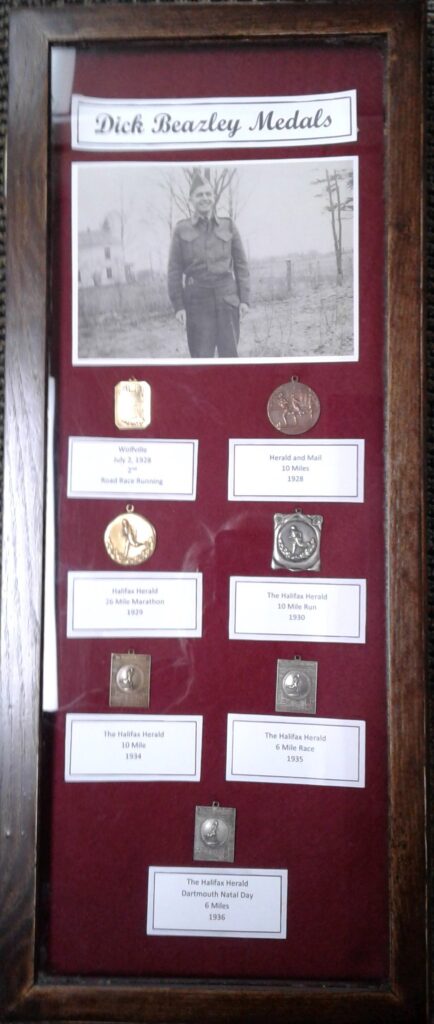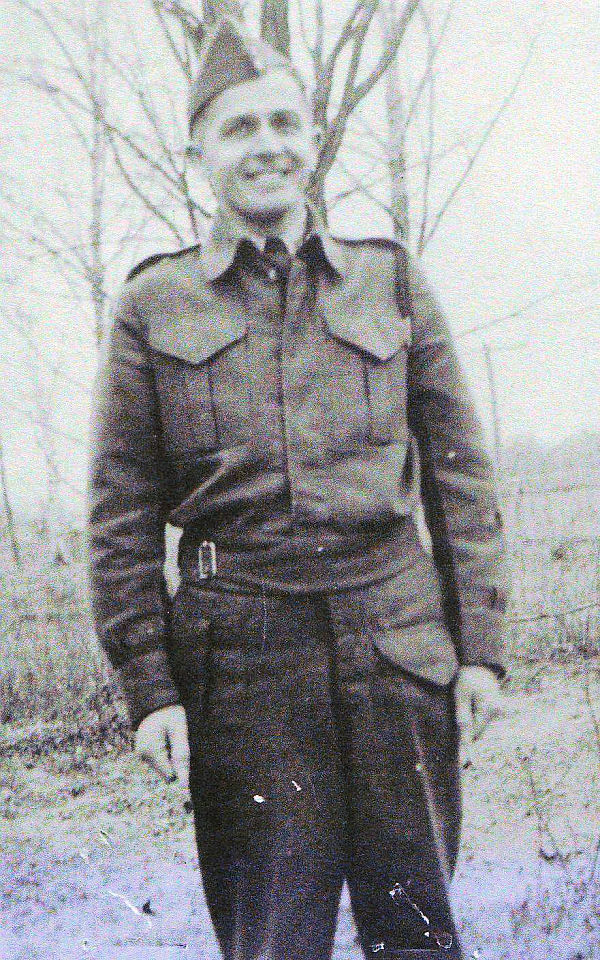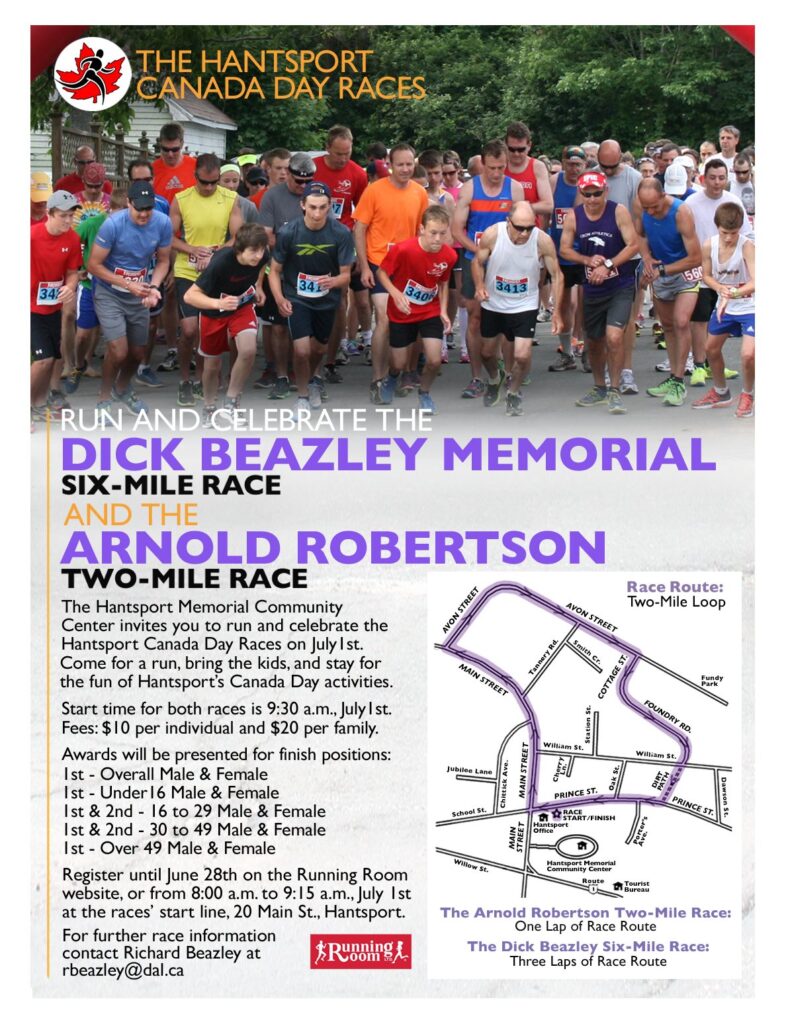Richard Paul (Dick) Beazley was born on June 19th, 1911 in Hantsport, Nova Scotia, the son of Gabriel Beazley and Blanche Wambolt. His older brother Fred was an aspiring runner who had competed in the Halifax Herald and Evening Mail Modified Marathon. On October 23rd, 1926 Fred invited Dick to train with him so that he could judge his pace during practice. When Fred returned home at the end of his run, Dick was waiting for him. Dick had outpaced his brother for the entire run! This made Fred decide to give up on running and encourage his younger brother to train and pursue running instead. In 1927, at the age of 16, Dick Beazley won his first road race. The race was 8 miles, from Hantsport to Windsor. That same year, he was included in the list of runners in a news article promoting the upcoming Halifax Herald and Evening Mail Modified Marathon. This would be the first time he would run this race.
On July 2nd, 2019 the Hantsport and Area Historical Society received seven medals that Dick Beazley received during his time running. These medals came from Richard Beazley, son of Dick Beazley. The first medal is rectangular and gold in colour with the words ‘Wolfville, July 2, 1928, 2nd, Road Race Running’ inscribed above crossed laurels. The second medal is attributed to a Herald and Mail 10 mile race in 1928. It is round, bronze coloured, with the image of three runners on it. Because of the distance, it is likely this is the Herald and Mail Modified Marathon mentioned in articles published by the Herald and Mail.

The third medal in the box is round, gold coloured, with a runner above crossed laurels. This medal is from the Halifax Herald 26 mile marathon (a full marathon) in 1929. Dick placed 11th out of 24 runners in the marathon, with a time of 3 hours, 41 minutes, 0 seconds. That same year, Dick placed 1st in the Hantsport Victoria Day 1-Mile Road Race. Dick is commonly referred to with words related to how young he is or appears, and how thin he appears. He is called youthful, and appearing like a schoolboy, and is called slim and spindly. Articles often also make note of how happy he is. He seemed to enjoy the race no matter how he faired and he was perceived to be a good sport. Dick also appears to be a very consistent runner, always placing well in the pack.
In 1930, Dick placed 10th of 36 runners in the Halifax Herald and Evening Mail Modified Marathon. The fourth medal is for this 10 mile race. It is rectangular in shape, silver in colour, with corners that turn outwards that are framed by little decorations. There is a circular depression in the middle, with a runner above crossed laurels. Dick also competed in the Halifax Herald and Evening Mail Marathon, placing 4th of 10 runners, and ran in the Wolfville Centennial Celebration 7-mile road race, placing 3rd.
Dick lived during the Great Depression, so he had to work very hard to make a living. As a teenager, Dick worked at Murray’s Lumber Mill. When he was older, he worked in at the Minas Basin Pulp and Power Mill. He worked 8-12 hour shifts, six days a week. He trained after work, often in darkness.
There weren’t many organized road races in the Atlantic Provinces in Dick’s time. The ones that usually ran were the New Glasgow Evening News 10-Mile Road Race, the Dartmouth Natal Day 6-Mile Road Race, and the Halifax Herald and Mail Road Race. The Herald and Mail Race was either run as a full 26-mile marathon or as a modified 10-mile marathon. Dick never had a car, and needed to be driven by someone else or needed to travel by train to these races. In 1931 Dick ran in the Halifax Herald and Halifax Mail Modified Marathon placing 10th of 46 with a time of 1 hour, 0 minutes, 45 seconds. He also ran in the Halifax Herald and Halifax Mail Marathon placing 3rd of 18 with a time of 3 hours, 19 minutes, 23 seconds. In 1932 Dick ran in the New Glasgow Evening News 10-Mile Road Race placing 6th of 33. He ran in the Halifax Herald and Halifax Mail Modified Marathon placing 6th of 50 with a time of 57 minutes, 58 seconds, and ran in the Dartmouth Natal Day 6-Mile Road Race, placing 4th.
In 1933, Dick ran in the Halifax Herald and Halifax Mail Modified Marathon placing 7th of 37 runners with a time of 54 minutes, 37 seconds. In his time racing Dick ran against the best runners in Atlantic Canada. Even runners from the northeastern United States would come. Dick also ran as a member of local running clubs and contributed in the team competitions.
The fifth medal is from the Halifax Herald 10-mile, 1934. The medal is rectangular, gold in colour, with the words ‘The Halifax Herald’ at the top. There is a raised circle in the middle, with a runner. The medal has the appearance of the front page of a newspaper. Dick ran in this modified marathon placing 7th of 37, and was the 1st place member of the Halifax North Star Athletic club, which won the team championship. Dick appears in a photograph with his teammates in the Halifax Herald. The Halifax Herald paper made particular mention that Dick was able to secure the 7th place spot behind Jimmy Hennigan who had far outpaced him the prior year. He also ran in the Dartmouth Natal Day 6-mile Road Race, placing 1st with a time of 33 minutes, 34 seconds.
In 1935, Dick ran in the Halifax Herald Modified Marathon and placed 9th of 26 runners with a time of 59 minutes, 32 seconds, and was the 1st place member of the Halifax North Star Athletic Club which won the championship. The sixth medal is for this race, stated to be a 6-mile modified marathon as opposed to the other 10-mile modified marathons. The medal has the same newspaper appearance as the fifth medal, but is more silver in colour. He also ran in the Dartmouth Natal Day 6-Mile Road Race, placing 3rd. According to the Halifax Herald, Dick won the Dartmouth Natal Day 6-Mile Road Race by a foot. On his 24th birthday, the 19th of June, 1935 he married Mary Elizabeth Benedict.
The seventh medal is from the 1936 Halifax Herald Dartmouth Natal Day 6-mile. Dick placed 3rd. The medal appears like a newspaper, as the fifth and sixth medals do. The seventh medal is silver in colour, like the sixth medal. It is interesting to see that the same medal design was used for both the Halifax Herald races and the Dartmouth Natal Day race. Dick placed 5th of 45 in the Halifax Herald Modified Marathon with a time of 57 minutes, 0 seconds, and placed 2nd for the Halifax North Star Athletic Club team championship. Dick and Mary’s first son, Leslie, was born June 27th, 1936.
In 1937, Dick ran in the Halifax Herald Modified Marathon, placing 4th of 37 with a time of 57 minutes, 36 seconds. He was the 2nd place member of the Hants County Marathon Club, which was the runner-up for the team championship. Silas MacLellan was first in the Hants County Marathon Club, followed by Dick. Silas MacLellan beat Dick by 15 seconds, who beat John Gero by 28 seconds. Writing about the Halifax Herald Modified Marathon, the Halifax Herald described him as being a cagey performer with a smooth, easy pace. Dick ran in the Dartmouth Natal Day 6-Mile Road Race, placing 2nd with a time of 32 minutes, 35 seconds. In the Windsor to Hantsport 8-Mile Road Race he placed 1st with a time of 41 minutes, 31 seconds. He placed 1st of 16 in the Memorial Marathon, with a time of 2 hours, 47 minutes, 51 seconds. The Memorial Marathon was held on November 11th by the Nova Scotia Veterans League.
In 1938, Dick ran in the Boston Marathon, placing 40th of 180. He ran in the New Glasgow Evening News 10-Mile Road Race, placing 2nd of 16 with a time of 57 minutes, 28 seconds. The Halifax Herald recounts John Paul beating Dick in the New Glasgow Evening News 10 Mile Race by half a second. John Paul ran it in 57 minutes, 27.5 seconds, Dick ran it in 57 minutes, 28 seconds. Two weeks later at the Halifax Herald Modified Marathon, Dick beat John Paul, overtaking him for second place. John Paul had a stomach cramp early in the race and was laboring when he crossed the line. The race was won by Con Olsen from Cape Breton. Dick placed 2nd of 36 with a time of 57 minutes, 29 seconds. He also ran in the Springhill 17-Mile Road Race, placing 2nd of 8 runners, ran in the Dartmouth Natal Day 6-Mile Road Race, placing 1st, and ran in the Upper Kennetcook 5-Mile Road Race, placing 1st.
In 1939, Dick ran in the Halifax Herald Modified Marathon, placing 2nd of 35 with a time of 56 minutes, 21 seconds. He was the 2nd place member in the Hants County Marathon Club which was the runner up team. For the Halifax Herald Modified Marathon, Dick was close with the winner Leroy White for a good portion of the race. They even talked with each other as they ran together. At the end of the race, Dick commented “That White’s a fine boy… and he can sprint! I missed my chance on the Arm Hill. He had too much speed for me on the track. He’s going to go places.” Dick ran in the Dartmouth Natal Day 6-Mile Road Race, placing 4th, and was the 1st place member of the Hants County Marathon Club, which won the team championship. In 1939, Dick ran in the Halifax Herald Modified Marathon, placing 2nd of 27 runners with a time of 56 minutes, 2 seconds. He was 1st place member of the Hants County Marathon Club, which won the team championship. Dick and Mary had their second son Richard on May 12th, 1939, just less than four months from when Canada would enter the Second World War on September 10th.

Dick was 28 when the Second World War was declared. Races during the war years were sparse. The Dartmouth Natal Day 6-Mile Road Race was continued, but attendance to these races was small. People took notice that prominent runners like Dick were absent for wartime races. In 1943, Dick and Mary had their third son, Wayne, on December 9th. Dick supposedly anguished about being home in Nova Scotia during the war. He felt he ought to be overseas like the other young men his age. On February 2nd, 1944, Dick enlisted in the Canadian Army and became a part of the 1st Battalion North Shore (New Brunswick) Regiment. At this point in the war, Nazi Germany was still in control of the majority of Europe. The Soviet Union was on the offensive in the Eastern front and plans were underway for D-Day, the Allied Invasion of Europe on the Western front. On June 6th, 1944, Allied forces landed at Normandy and the Western and Eastern Front began to close in around Berlin.
In 1944, Dick ran the Dartmouth Natal Day 6-Mile Road Race, placing 2nd, and being the 1st in the Camp Aldershot Cross-Country team, which won the team championship. The Halifax Modified Marathon was run on September 5. Dick did not participate in this race as he was waiting to embark overseas. The race wasn’t run again until 1982. On October 14th, at the age of 33, Dick made his way overseas to support the Allied push into Nazi Germany. He travelled from Halifax to England, and in January, left England for the European Continent. At this time, the Allied forces staged a pincer attack with Canadian and British forces advancing on the north of the Reichswald in Operation Veritable, and the American forces advancing on the south of the Reichswald in Operation Grenade. Operation Veritable met challenged fighting and was renamed to Operation Blockbuster for a renewed push. On February 26th, 1945, Dick Beazley participated in the first day of Operation Blockbuster and was killed in action, leaving Mary widowed and Leslie, Richard, and Wayne without their father. The war would end three months later.

On July 1st 1947, members of Hantsport Lucknow Branch No. 109 Royal Canadian Legion got together and decided to commemorate Dick by hosting a road race. The Dick Beazley Memorial Six-Mile Race is the second-longest annually-run race in Nova Scotia after the Dartmouth Natal Day Six-Mile Race.
In December 2001 a nomination package was sent to the Nova Scotia Sports Hall of Fame by Richard Beazley Jr. and Dick was inducted into the hall of fame for his running career.
Due to the ongoing COVID-19 pandemic the race on 1 July 2021 will be symbolic, observed by a few runners and walkers, friends and family, to carry on the tradition.
The medals featured in the Dorie and Garnet McDade Heritage Centre are not the full extent of running awards won by Dick during his time running. Unfortunately most of the trophies Dick won were destroyed in a fire that burned down a jewelry store where they had been sent for cleaning. If you would like to visit our permanent display about Dick Beazley and see what we do have related to him and the memorial race, follow us on Facebook @HantsportAreaHistoricalSociety and Instagram @hantsportheritagecentre to keep up to date with when you’ll be able to visit once again. If you have a story to tell, or have artifacts you’d like to donate and display in the Dorie and Garnet McDade Heritage Centre, please reach out to us on Facebook and Instagram.
